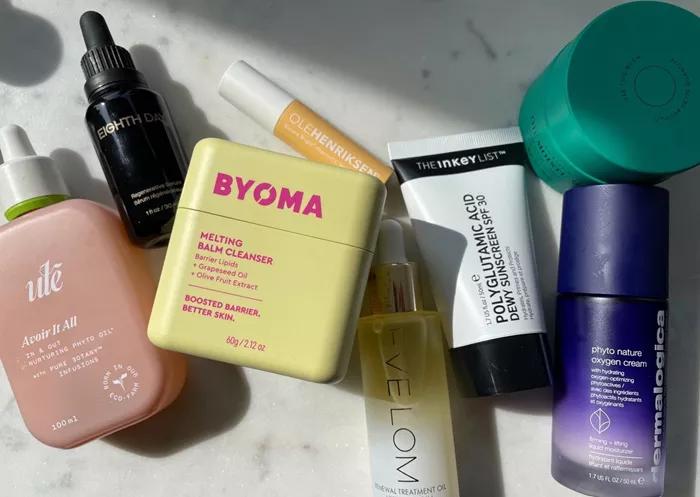Taking care of your skin doesn’t have to be complicated. A simple skincare routine can keep your skin healthy and glowing. In this guide, we will walk you through the basics of skincare and how to build a simple routine that works for you.
Understanding Your Skin Type
Before you start any skincare routine, it’s important to know your skin type. Your skin type determines which products will work best for you. There are five main skin types: normal, oily, dry, combination, and sensitive.
- Normal skin is well-balanced and not too oily or dry.
- Oily skin produces excess oil, especially around the T-zone (forehead, nose, and chin).
- Dry skin feels tight and may flake or crack.
- Combination skin has characteristics of more than one skin type, like oily in some areas and dry in others.
- Sensitive skin is prone to redness, irritation, and reactions to products.
How to Have a Simple Skincare Routine
Step 1: Cleanse Your Skin
The first step in any skincare routine is cleansing. Cleansing removes dirt, oil, and impurities from your skin. It is important to choose a gentle cleanser that suits your skin type. For oily skin, you may need a foaming cleanser, while a hydrating cleanser works better for dry skin.
Use lukewarm water and apply the cleanser in a circular motion. Gently massage your face for about 30 seconds, then rinse off with water. Avoid using hot water, as it can strip your skin of its natural oils.
Step 2: Use a Toner (Optional)
A toner can help remove any leftover impurities and balance the skin’s pH. If you have oily skin, you might benefit from a toner with ingredients like salicylic acid. For dry or sensitive skin, choose a hydrating toner with soothing ingredients like aloe vera.
Apply the toner with a cotton pad or your hands, and gently swipe it across your face. This step is optional, but it can help refine the texture of your skin.
Step 3: Apply a Serum
Serums are lightweight treatments packed with active ingredients that target specific skin concerns. For example, if you have acne-prone skin, you may want a serum with salicylic acid. If you’re looking for anti-aging benefits, a serum with vitamin C or retinol may be ideal.
Apply a small amount of serum to your face after cleansing (and toning, if you choose to use a toner). Gently press it into your skin for better absorption.
Choosing the Right Serum
For a simple routine, you don’t need to use many serums. Choose one based on your primary skin concern, whether it’s hydration, acne, or anti-aging. Some serums can even help with more than one issue.
Step 4: Moisturize
Moisturizing is essential to keep your skin hydrated and to lock in the benefits of your cleanser and serum. Even if you have oily skin, it’s important to moisturize. Look for a lightweight, non-comedogenic moisturizer that won’t clog your pores.
If you have dry skin, choose a thicker moisturizer that can help restore hydration. For sensitive skin, opt for a fragrance-free, gentle formula to avoid irritation.
Step 5: Protect Your Skin with Sunscreen
Sunscreen is one of the most important steps in a skincare routine. It helps protect your skin from the harmful effects of UV rays, which can cause premature aging and increase the risk of skin cancer. Choose a broad-spectrum sunscreen with SPF 30 or higher.
Apply sunscreen as the final step in your routine every morning, even if you’re staying indoors. Reapply it throughout the day, especially if you’re outside for extended periods of time.
How to Choose the Right Sunscreen
There are two main types of sunscreens: physical (mineral) and chemical. Physical sunscreens contain ingredients like zinc oxide or titanium dioxide and work by reflecting UV rays. Chemical sunscreens absorb UV rays and turn them into heat.
If you have sensitive skin, opt for a physical sunscreen. For oily skin, a lightweight chemical sunscreen might be a better choice.
Additional Tips for Healthy Skin
While the steps mentioned above form the foundation of a simple skincare routine, there are additional habits that can improve your skin health.
- Stay hydrated by drinking plenty of water throughout the day.
- Eat a balanced diet rich in fruits, vegetables, and healthy fats.
- Get enough sleep to allow your skin to repair itself overnight.
- Don’t pick at your skin, as this can cause scarring and further breakouts.
- Clean your makeup brushes regularly to avoid bacteria buildup.
Beauty Trends to Watch
Beauty trends can influence skincare routines. It’s always good to stay updated with new products and methods. However, remember that the basics of skincare—cleansing, moisturizing, and sun protection—will never go out of style.
Conclusion
Building a simple skincare routine doesn’t have to be overwhelming. By focusing on the basics—cleansing, toning, moisturizing, and protecting your skin from the sun—you can maintain healthy, glowing skin. It’s also important to listen to your skin and adjust your routine based on how it feels.
Remember, a simple skincare routine is about consistency. Stick to your routine, and over time, you’ll see the benefits.


